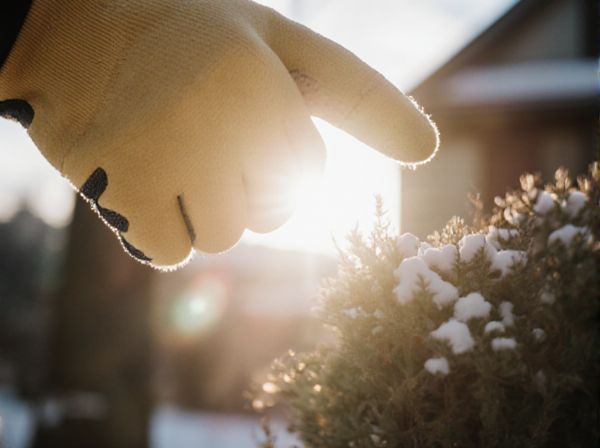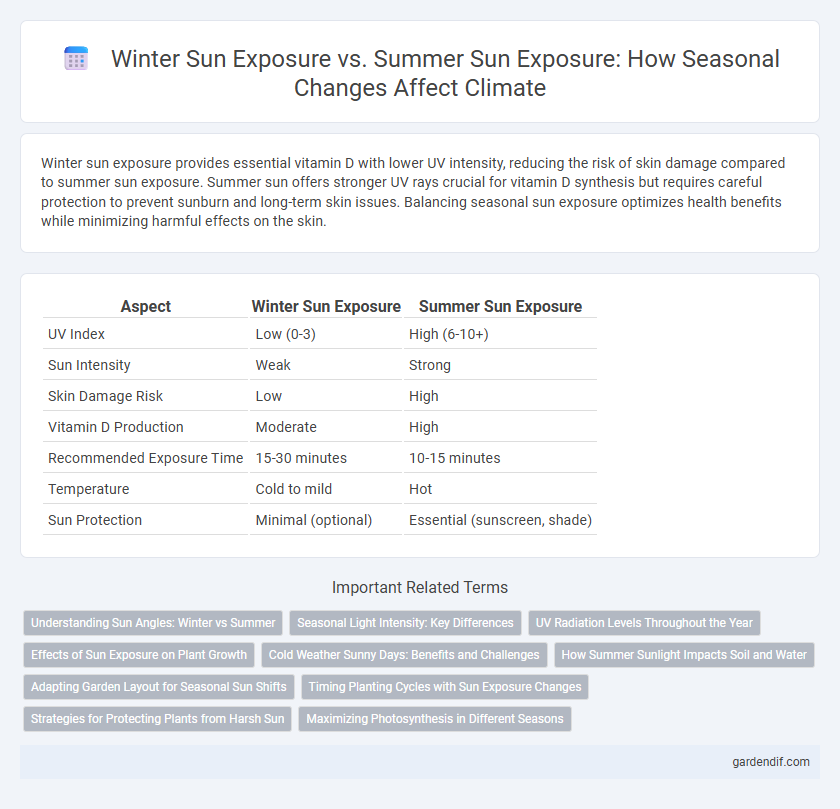
Winter Sun Exposure vs Summer Sun Exposure Illustration
Winter sun exposure provides essential vitamin D with lower UV intensity, reducing the risk of skin damage compared to summer sun exposure. Summer sun offers stronger UV rays crucial for vitamin D synthesis but requires careful protection to prevent sunburn and long-term skin issues. Balancing seasonal sun exposure optimizes health benefits while minimizing harmful effects on the skin.
Table of Comparison
| Aspect | Winter Sun Exposure | Summer Sun Exposure |
|---|---|---|
| UV Index | Low (0-3) | High (6-10+) |
| Sun Intensity | Weak | Strong |
| Skin Damage Risk | Low | High |
| Vitamin D Production | Moderate | High |
| Recommended Exposure Time | 15-30 minutes | 10-15 minutes |
| Temperature | Cold to mild | Hot |
| Sun Protection | Minimal (optional) | Essential (sunscreen, shade) |
Understanding Sun Angles: Winter vs Summer
Sun angles significantly differ between winter and summer, affecting the intensity and duration of sun exposure. In winter, the sun remains lower in the sky, resulting in longer shadows and reduced solar radiation, which minimizes heat absorption. Conversely, summer sun angles are higher, leading to shorter shadows and increased solar energy that contributes to warmer temperatures and greater UV exposure.
Seasonal Light Intensity: Key Differences
Winter sun exposure delivers lower seasonal light intensity with a sun angle between 15 to 30 degrees, resulting in reduced UV radiation and limited vitamin D synthesis. In contrast, summer sun exposure features a higher sun angle of 60 to 75 degrees, intensifying light intensity and increasing UV index levels significantly. This seasonal variation affects human health, plant growth cycles, and solar energy efficiency, necessitating adaptive measures across ecosystems.
UV Radiation Levels Throughout the Year
UV radiation levels vary significantly between winter and summer, with summer months experiencing up to three times higher UV index values due to the sun's higher position in the sky and longer daylight hours. Winter sun exposure generally results in lower UV radiation levels, reducing the risk of skin damage but also limiting vitamin D synthesis. Monitoring seasonal UV fluctuations is crucial for optimizing sun protection strategies and maintaining healthy skin year-round.
Effects of Sun Exposure on Plant Growth
Winter sun exposure provides lower light intensity and shorter photoperiods, which can slow down photosynthesis and plant growth compared to summer. Summer sun exposure delivers higher UV radiation and extended daylight hours, promoting increased photosynthetic activity and accelerated development in many plant species. Excessive summer sun without adequate water can cause heat stress and photoinhibition, negatively impacting plant health and productivity.
Cold Weather Sunny Days: Benefits and Challenges
Cold weather sunny days offer important benefits such as enhanced Vitamin D synthesis despite lower temperatures, which supports immune function and mood regulation during winter months. However, challenges include increased risks of skin damage due to UV reflection off snow and reduced outdoor activity time because of cold conditions. Balancing sun exposure with appropriate skin protection and clothing is essential to maximize health benefits while minimizing adverse effects in winter climates.
How Summer Sunlight Impacts Soil and Water
Summer sunlight significantly increases soil temperature, accelerating organic matter decomposition and nutrient mineralization, which enhances soil fertility. Higher solar radiation during summer promotes evaporation rates, reducing soil moisture and influencing water availability for plants. Intense summer sun exposure can lead to soil drying and increased evaporation from water bodies, impacting local hydrological cycles and water resource management.
Adapting Garden Layout for Seasonal Sun Shifts
Seasonal sun shifts significantly impact garden layout, requiring thoughtful adaptation to optimize plant growth and health. Winter sun angles are lower and provide less intense light, encouraging gardeners to place sun-loving plants where they receive maximum exposure, such as south-facing beds and raised areas. In summer, with higher sun angles and stronger radiation, strategic placement of shade-tolerant species and the use of natural or artificial shading can prevent overheating and sunburn, promoting a balanced microclimate throughout the garden year-round.
Timing Planting Cycles with Sun Exposure Changes
Winter sun exposure provides lower intensity and shorter duration of sunlight compared to summer, crucial for timing planting cycles that depend on gradual light increases for seed germination and growth phases. Aligning planting schedules with the transition from shorter winter days to longer summer days maximizes photosynthetic efficiency and crop yield by ensuring plants receive optimal light exposure at each developmental stage. Understanding solar angles and daylight duration shifts between seasons enables precise adjustment of sowing periods, enhancing resilience to climatic fluctuations and improving agricultural productivity.
Strategies for Protecting Plants from Harsh Sun
Winter sun exposure often involves lower UV intensity but can cause desiccation and frost damage, requiring protective measures like mulching and windbreaks to conserve soil moisture and reduce cold stress. Summer sun exposure brings higher UV radiation and heat stress, making shade cloths, reflective mulches, and regular watering essential to prevent leaf scorch and dehydration. Implementing specific strategies such as selecting sun-tolerant plant varieties and applying UV-protective coatings enhances plant resilience throughout seasonal sun fluctuations.
Maximizing Photosynthesis in Different Seasons
Winter sun exposure offers lower light intensity but longer daylight hours, which can maximize photosynthesis in cold-tolerant plants by extending the active period for carbon fixation. Summer sun exposure provides higher light intensity and optimal temperatures, enhancing photosynthetic rates and chlorophyll synthesis for most plant species. Adapting plant care to seasonal light variations ensures efficient energy capture and sustained growth throughout the year.
Winter Sun Exposure vs Summer Sun Exposure Infographic

 gardendif.com
gardendif.com